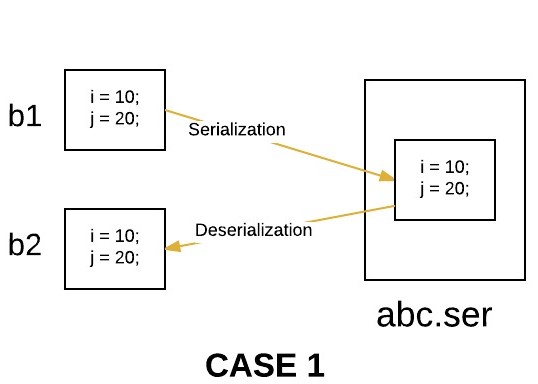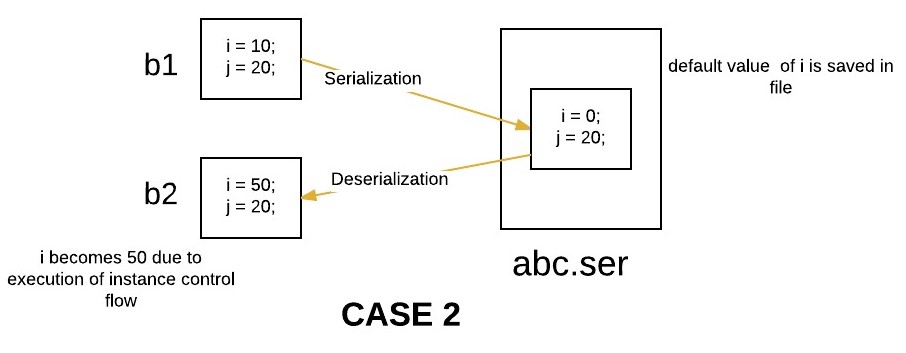📌 相关文章
- Java中带有继承的对象序列化
- Java中带有继承的对象序列化(1)
- Java序列化中的对象图(1)
- Java序列化中的对象图
- Java继承类的对象创建
- Java继承类的对象创建(1)
- 继承类的Java对象创建(1)
- 继承类的Java对象创建
- Java-序列化
- Java-序列化
- Java-序列化(1)
- 打印 java 对象继承的类 - Java (1)
- Java中的序列化和反序列化
- Java中的序列化和反序列化(1)
- Java继承
- Java中的继承(1)
- Java-继承(1)
- Java继承
- Java-继承
- Java-继承
- Java-继承(1)
- Java中的继承
- Java中的继承
- Java继承(1)
- Java中的序列化和反序列化示例
- 打印 java 对象继承的类 - Java 代码示例
- 什么是 java 中的序列化和反序列化 (1)
- java代码示例中的继承
- 将对象反序列化为字典 c# (1)
📜 Java中带有继承的对象序列化
📅 最后修改于: 2020-03-23 01:24:24 🧑 作者: Mango
先决条件: 继承
序列化是一种将对象的状态转换为字节流的机制。反序列化是相反的过程,其中字节流用于在内存中重新创建实际的Java对象。该机制用于持久化对象。
关于继承有一些序列化的情况:
情况1:如果超类是可序列化的,则子类是可自动序列化的。如果超类是可序列化的,则默认情况下,每个子类都是可序列化的。因此,即使子类没有实现Serializable接口(并且它的超类实现了Serializable),我们也可以序列化子类对象。
// Java展示如果超类是可序列化的,则子类是可自动序列化的
import java.io.FileInputStream;
import java.io.FileOutputStream;
import java.io.ObjectInputStream;
import java.io.ObjectOutputStream;
import java.io.Serializable;
// 超类 A
// 实现了序列化接口
class A implements Serializable
{
int i;
// 构造函数
public A(int i)
{
this.i = i;
}
}
// 子类 B
// 没有实现序列化接口
class B extends A
{
int j;
// 构造函数
public B(int i, int j)
{
super(i);
this.j = j;
}
}
// 测试代码
public class Test
{
public static void main(String[] args)
throws Exception
{
B b1 = new B(10,20);
System.out.println("i = " + b1.i);
System.out.println("j = " + b1.j);
/* 序列化B对象 */
FileOutputStream fos = new FileOutputStream("abc.ser");
ObjectOutputStream oos = new ObjectOutputStream(fos);
// 序列化B对象方法
oos.writeObject(b1);
// 关闭stream
oos.close();
fos.close();
System.out.println("对象被序列化");
/* 反序列化B对象 */
FileInputStream fis = new FileInputStream("abc.ser");
ObjectInputStream ois = new ObjectInputStream(fis);
// 反序列化B对象方法
B b2 = (B)ois.readObject();
// 关闭stream
ois.close();
fis.close();
System.out.println("对象被反序列化");
System.out.println("i = " + b2.i);
System.out.println("j = " + b2.j);
}
}输出:
i = 10
j = 20
对象被序列化
对象被反序列化
i = 10
j = 20
- 如果超类不可序列化,则子类仍可以序列化:即使超类未实现Serializable接口,但如果子类本身实现Serializable接口,我们也可以对子类对象进行序列化。因此,可以说要序列化子类对象,超类不必是可序列化的。但是在这种情况下,超类实例在序列化期间会发生什么。以下过程对此进行了说明。
当一个类可序列化但其超类不是可序列化时会发生什么?
- 序列化:进行序列化时,如果任何实例变量都从不可序列化的超类继承,则JVM会忽略该实例变量的原始值,并将默认值保存到文件中。
- 反序列化:反序列化时,如果存在任何不可序列化的超类,则JVM将在超类中执行实例控制流。为了在一个类中执行实例控制流,JVM将始终调用该类的默认无参数构造函数。因此,每个不可序列化的超类都必须包含默认构造函数,否则我们将获得运行时报错。
// Java展示序列化子类时,超类不必可序列化 import java.io.FileInputStream; import java.io.FileOutputStream; import java.io.ObjectInputStream; import java.io.ObjectOutputStream; import java.io.Serializable;; // 超类 A // A没有实现序列化接口 class A { int i; // 参数化构造器 public A(int i) { this.i = i; } // 默认构造器 public A() { i = 50; System.out.println("A的构造器被调用"); } } // 子类B // 实现序列化接口 class B extends A implements Serializable { int j; // 参数化构造器 public B(int i,int j) { super(i); this.j = j; } } // 测试代码 public class Test { public static void main(String[] args) throws Exception { B b1 = new B(10,20); System.out.println("i = " + b1.i); System.out.println("j = " + b1.j); // 序列化B对象 FileOutputStream fos = new FileOutputStream("abc.ser"); ObjectOutputStream oos = new ObjectOutputStream(fos); oos.writeObject(b1); // 关闭streams oos.close(); fos.close(); System.out.println("对象被序列化"); // 反序列化B对象 FileInputStream fis = new FileInputStream("abc.ser"); ObjectInputStream ois = new ObjectInputStream(fis); B b2 = (B)ois.readObject(); // 关闭streams ois.close(); fis.close(); System.out.println("对象被反序列化"); System.out.println("i = " + b2.i); System.out.println("j = " + b2.j); } }输出:
i = 10 j = 20 对象被序列化 A的构造器被调用 对象被反序列化 i = 50 j = 20
- 如果超类是可序列化的,但是我们不希望子类被序列化:在Java中,没有直接的方法可以防止子类被序列化。程序员实现此目标的一种可能方法是在子类中实现writeObject()和readObject()方法,并且需要从这些方法中抛出NotSerializableException异常。这些方法分别在序列化和反序列化期间执行。通过重写这些方法,我们仅实现了自己的自定义序列化。
// Java程序展示如何防止子类被序列化 import java.io.FileInputStream; import java.io.FileOutputStream; import java.io.IOException; import java.io.NotSerializableException; import java.io.ObjectInputStream; import java.io.ObjectOutputStream; import java.io.Serializable; // 超类A // 实现序列化接口 class A implements Serializable { int i; // 参数化构造器 public A(int i) { this.i = i; } } // 子类B // B没有实现序列化接口 class B extends A { int j; // 构造器 public B(int i,int j) { super(i); this.j = j; } // 通过实现writeObject方法, // 我们可以阻止子类实现序列化 private void writeObject(ObjectOutputStream out) throws IOException { throw new NotSerializableException(); } // 通过实现readObject方法, // 我们可以阻止子类实现反序列化 private void readObject(ObjectInputStream in) throws IOException { throw new NotSerializableException(); } } // 测试代码 public class Test { public static void main(String[] args) throws Exception { B b1 = new B(10, 20); System.out.println("i = " + b1.i); System.out.println("j = " + b1.j); // 序列化B对象 //Saving of object in a file FileOutputStream fos = new FileOutputStream("abc.ser"); ObjectOutputStream oos = new ObjectOutputStream(fos); oos.writeObject(b1); // 关闭streams oos.close(); fos.close(); System.out.println("对象被序列化"); // 反序列化B对象 FileInputStream fis = new FileInputStream("abc.ser"); ObjectInputStream ois = new ObjectInputStream(fis); B b2 = (B)ois.readObject(); // 关闭streams ois.close(); fis.close(); System.out.println("对象被反序列化"); System.out.println("i = " + b2.i); System.out.println("j = " + b2.j); } }输出:
i = 10 j = 20 Exception in thread "main" java.io.NotSerializableException at B.writeObject(Test.java:44)